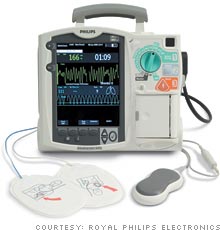 |
| The HeartStart MRx, with Q-CPR feature. |
|
|
|
NEW YORK (CNNMoney.com) -
A talking defibrillator, the first of its kind, could soon be in the hands of paramedics to help them focus on one of the most important but often downplayed aspects of CPR following a heart attack, chest compressions.
Q-CPR, a monitoring and feedback system that speaks instructions to stressed-out, multi-tasking paramedics, will hit the streets in the next few weeks as an optional feature for the HeartStart MRx monitor/defibrillator.
"It's like a very good instructor whispering into your ear, telling you what to do," said Dr. Kenneth Morallee, vice president of strategic development for Laerdal, the Norwegian co-developer of the new device. "If you do it well, it shuts up."
Q-CPR measures chest compressions and provides verbal feedback to paramedics as they try to revive patients stricken by sudden cardiac arrest, which happens when the heart stops beating. Laerdal co-designed the Q-CPR system with the Netherlands-based Royal Philips Electronics.
The American Heart Association estimates that 95 percent of patients die when they get sudden cardiac arrest outside of hospitals, including the ones who receive CPR from paramedics. Just this week, the AHA updated its CPR guidelines, with greater emphasis on the importance of chest compressions. Recent studies, partly funded by Philips, showed that depth and frequency of chest compressions are vital in keeping cardiac patients alive, but that paramedics were focusing too much on other aspects of CPR.
With Q-CPR, paramedics' compressions are measured by hand pads that are placed on the patient's chest. If the paramedics aren't pushing hard enough or frequently enough, the machine lets them know with verbal commands to "press deeper."
Dr. Petter Steen, professor in the surgical division at Ulleval University Hospital in Oslo, helped conduct the studies, which pinpointed chest compressions as "the most important factor for survival" in patients with sudden cardiac arrest. However, tests showed that paramedics were so busy "putting in needles and clearing the airways" that they often failed to deliver sufficient chest compressions, said Steen. But the Q-CPR devices, with its spoken instructions, brought paramedics up to par with guidelines, said Steen.
"They do half the compressions they need to do and they're not pressing hard enough," said Steen, referring to paramedics who don't use Q-CPR. "But with the device, we're up to twice the heart compressions that we had before."
Nancy Hinckley, product marketing manager for Philips (up $0.75 to $28.69, Research), said her company started shipping the devices worldwide and "you'll begin to see it in use in the first quarter of 2006." Hinckley said the basic MRx costs $9,250, and the Q-CPR feature costs an additional $3,795. Defibrillators loaded with the full array of optional features cost up to $30,000, said Hinckley.
Scott Geels, analyst for Bernstein, said the Q-CPR isn't likely to have a big financial impact on Philips. Geels said that defibrillators make up a small slice of Philips' sales, accounting for about the half the worldwide market of $500 million to $600 million in annual revenue. Geels said that 75 percent of Philips' sales, which totaled $36 billion in 2004, come from medical imaging equipment including X-Ray machines, MRIs and ultrasound.
"This is a relatively small part of their business," said Geels, who has a "neutral" rating for Philips. "It's not a make or break for the company."
To read about new medical imaging from Novartis, click here.

|